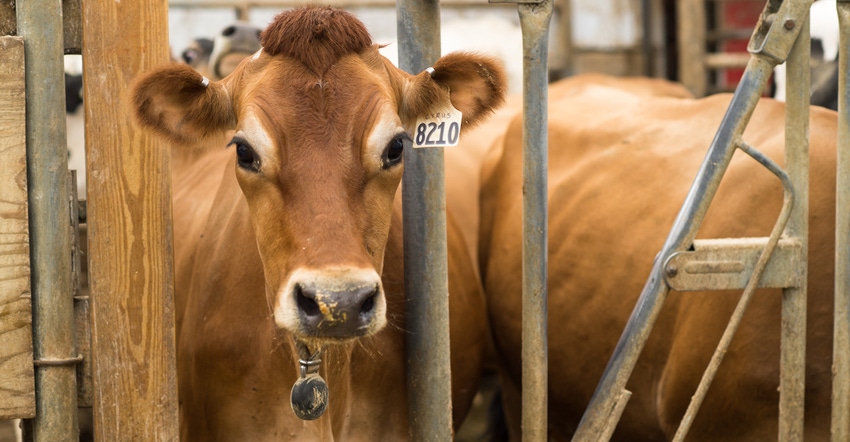August 23, 2018

Like a lot of farmers — and a lot of circumstances in agriculture — David Vanderstappen didn’t see this coming.
He walked out his door in the wee hours of June 12 to find his barn on fire, with 93 dairy cows inside. Flames licked out from the haymow and smoke rolled. Every cow was still standing in her stall, tied in place. He ran in and saved one. Saved a couple more. Kept going. Smoke was everywhere. A farm employee joined him, and together, they got every cow out.
“They all walked out of the barn almost like normal,” David recalls.
Built by his dad and grandfather, the barn was a total loss. Fire crews saved silos and nearby buildings. But the barn and milking parlor were gone.
Neighbors Joel and Linnea Kooistra opened their farm to the cows, having just retired from full-time milking earlier this year.
Big and hard decisions
Now what? David and his wife, Katie, aren’t sure. Insurance won’t come close to covering the cost of a new barn — pegged at $1.2 million. They’re a young family living near Hebron, Ill., with five small children. If they rebuild, it won’t be for 90 to 100 head; it’ll be for closer to 200. That’s double their current size. Their processor can’t take any more milk because it doesn’t have a market for it. And on top of all that, it’s a specialty milk processor. That means any day, a letter in the mail could mean David doesn’t have a place to sell his milk.
The Vanderstappens can’t keep on the way they are, but they can’t grow either.
“That’s the kicker,” David says. “I ran into a burning barn to save all those cows. Then a couple months later, I might have to see them go down the road? I hate to think like that, but that’s the reality of it.”
David has talked to every other processor in the area, searching for a new market for additional milk. None said yes. Two didn’t say no. They’re hopeful markets will turn this fall. That could give David a contract and the security he — and a lender — need to rebuild.
“It’s frustrating. It’s a lot of uncertainty,” he says. He remembers when milk was $9, when he first started farming in 2009. With so much milk on the market, prices have sat at $14 to $15 for too many years now. “It’s been a slow bleed for a lot of us. You can’t make money there.”
Even more supply
Minus the fire, the Vanderstappens’ plight is like a lot of the dairy industry: They’re between a rock and a hard place, with few solid options and for the first time, a lack of places to sell their milk.
Trade wars haven’t done dairy farmers any favors either. About 17% of all U.S. milk is exported, much of it to Mexico. According to Tom Vilsack, U.S. Dairy Export Council, the dairy industry could lose $1.8 billion in the second half of 2018. Mexico buys a large amount of fluid milk, and for years has been the No. 1 export market for U.S. cheese. Tariffs are changing that, making it significantly less financially advantageous. The $12 billion bailout will be divided up among commodities, but it won’t open up markets that have closed or lost momentum in the trade war.
Pork producers all look back to 1998 as their watershed year — the year a ham was worth more than a whole hog, and farmers left the pork business. The industry consolidated and re-emerged vertically. For the dairy industry, this could be its watershed moment: a time that changes how the dairy business functions. A farmer just can’t sit in David Vanderstappen’s position very long.
For David, he’ll gather information. Check out other options. He’s got a small beef herd and raises corn and soybeans. But that’s not where his heart is.
“I really like milking cows. That’s what I’m going to try to do.”
We really hope he gets to.
Comments? Email [email protected].
Beyond cows
All is not lost, no matter how hard it seems. Linnea Kooistra, a Master Farmer and veteran of more than her fair share of economic cycles, knows it’s hard to even contemplate not farming or not milking.
“But you’re more than just the work you do. If it turns out that it’s time to transition out of the industry and out of the work you do, your value as a person doesn’t change,” she says.
She’s right. We in agriculture identify with our job, our land, our cows, in ways the non-ag public may never understand. But still. At the end of the day, no matter how much of your identity is tied up in land or livestock, if it goes away, it doesn’t change your value as a person.
“Your connection to the land won’t change,” Kooistra adds. “Your heart and soul will still be there. You can’t let economic decisions drive you to lose everything of value — including your family and your personal health.”
If you feel like you need help, here are some resources:
• Call 800-FARM-AID (800-327-6243).
• Call the National Suicide Prevention Lifeline at 800-273-TALK (800-273-8255).
• Call 911 for an emergency.
• Call 211 for listening support, suicidal thoughts, mental health issues, crisis and referral (United Way of Illinois).
• Reach out to a loved one to talk about how you are feeling.
• Talk to friends, a pastor or a medical provider.
You May Also Like




